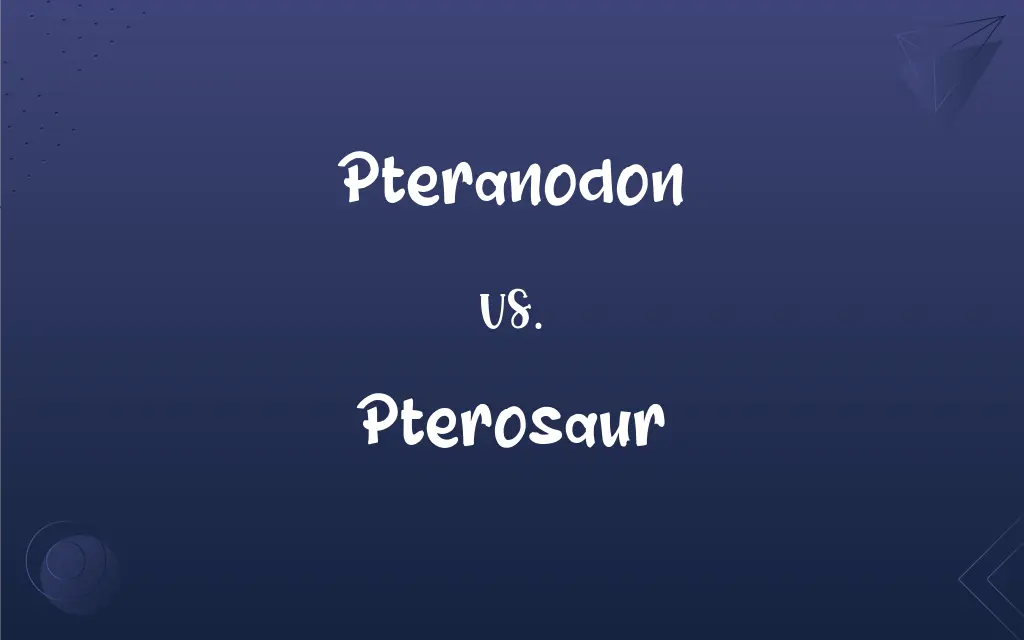Pteranodon vs. Pterosaur: What's the Difference?
By Harlon Moss & Aimie Carlson || Updated on May 23, 2024
Pteranodon is a specific genus of flying reptiles, while Pterosaur is a broader term encompassing all flying reptiles from the Mesozoic Era.

Key Differences
Pteranodon is a genus of pterosaurs that lived during the Late Cretaceous period. Known for its large wingspan and distinctive cranial crest, Pteranodon is one of the most well-known pterosaurs. These creatures were primarily fish-eaters, as evidenced by their fossilized remains often found in marine deposits. Pterosaur, on the other hand, refers to the entire order of flying reptiles that existed from the Late Triassic to the end of the Cretaceous period. This order includes a wide variety of genera, including Pteranodon, with significant diversity in size, shape, and ecological niches. Pterosaurs were the first vertebrates to achieve powered flight.
Pteranodon, as a genus, is a specific example within the broader category of pterosaurs. While all Pteranodon are pterosaurs, not all pterosaurs are Pteranodon. Pterosaurs include numerous genera with varying characteristics, such as different wing shapes, feeding habits, and habitats.
Pteranodon is notable for its wingspan, which could reach over 20 feet, and its toothless beak, adapted for a piscivorous diet. Pterosaurs, as a group, exhibit a range of adaptations, including different wing structures, sizes, and lifestyles, from small insectivores to large, fish-eating species.
Comparison Chart
Definition
Specific genus of flying reptiles
Entire order of flying reptiles
Time Period
Late Cretaceous
Late Triassic to end of Cretaceous
ADVERTISEMENT
Distinct Features
Large wingspan, cranial crest, toothless beak
Varied wing shapes, sizes, and ecological niches
Diet
Primarily fish-eaters
Diverse diets, including fish, insects, and small vertebrates
Example
Pteranodon longiceps
Pteranodon, Quetzalcoatlus, Pterodaustro
Pteranodon and Pterosaur Definitions
Pteranodon
Genus of pterosaurs.
Pteranodon longiceps had a wingspan of over 20 feet.
Pterosaur
Order of flying reptiles.
Pterosaurs were the first vertebrates to achieve powered flight.
ADVERTISEMENT
Pteranodon
Notable wingspan.
Some species of Pteranodon had wingspans exceeding 20 feet.
Pterosaur
Varied sizes and shapes.
Pterosaurs ranged from small insectivores to massive predators.
Pteranodon
Toothless beak.
Pteranodon had a toothless beak suited for catching fish.
Pterosaur
Included many genera.
Quetzalcoatlus was one of the largest pterosaurs, while Pterodaustro had specialized filter-feeding adaptations.
Pteranodon
Late Cretaceous period.
Pteranodon fossils are found in marine deposits from the Late Cretaceous.
Pterosaur
Existed from Late Triassic to end of Cretaceous.
Pterosaurs lived for over 150 million years.
Pteranodon
Distinctive cranial crest.
The cranial crest of Pteranodon is thought to have been used for display or aerodynamics.
Pterosaur
Diverse ecological niches.
Pterosaurs adapted to various environments, from coastal areas to inland regions.
Pteranodon
Any of several large pterosaurs of the genus Pteranodon of the Cretaceous Period, having a long crested head, a scooplike beak, no teeth, and a wingspan of over 8 meters (26 feet).
Pterosaur
Any of various extinct flying reptiles of the group Pterosauria, including the pterodactyls, of the Mesozoic Era, characterized by wings consisting of a membrane of skin extending from the side of the body to the very long fourth digit of the forelimb.
Pteranodon
A member of Pteranodon, a genus of large pterosaurs, the males of which had a bony crest on the back of the head.
Pterosaur
Any of several flying reptiles, of the extinct order †Pterosauria, including the pterodactyls.
Pteranodon
A genus of American Cretaceous pterodactyls destitute of teeth. Several species are known, some of which had an expanse of wings of twenty feet or more.
Pterosaur
A pterodactyl.
Pterosaur
Extinct flying reptile of the Jurassic and Cretaceous having a birdlike beak and membranous wings supported by the very long fourth digit of each forelimb
FAQs
What time period did Pteranodon live in?
Pteranodon lived during the Late Cretaceous period.
How do Pteranodon and Pterosaur differ?
Pteranodon is a specific genus within the broader order of Pterosaurs, which includes many different genera.
What did Pteranodon eat?
Pteranodon primarily ate fish.
What is a Pteranodon?
Pteranodon is a genus of pterosaurs known for its large wingspan and distinctive cranial crest.
Did Pteranodon have teeth?
No, Pteranodon had a toothless beak.
What is a Pterosaur?
Pterosaur refers to the entire order of flying reptiles that lived from the Late Triassic to the end of the Cretaceous period.
What are some characteristics of Pterosaurs?
Pterosaurs had varied wing shapes, sizes, and ecological niches, and they were the first vertebrates to achieve powered flight.
Are all Pterosaurs the same size?
No, Pterosaurs varied greatly in size, from small species to very large ones like Quetzalcoatlus.
Were Pteranodon good fliers?
Yes, Pteranodon was well-adapted for flying, with large wings and lightweight bodies.
Where are Pteranodon fossils found?
Pteranodon fossils are often found in marine deposits.
What was the wingspan of Pteranodon?
Some Pteranodon species had wingspans exceeding 20 feet.
What is a distinctive feature of Pteranodon?
Pteranodon had a large cranial crest and a toothless beak.
Did Pteranodon live near water?
Yes, Pteranodon often lived near coastal areas and marine environments.
Why are Pteranodon and Pterosaurs significant?
They provide insight into the evolution of flight and the diversity of prehistoric life.
What is a small Pterosaur?
Anurognathus is an example of a small Pterosaur.
How long did Pterosaurs exist?
Pterosaurs existed for over 150 million years, from the Late Triassic to the end of the Cretaceous.
Did all Pterosaurs have crests?
No, not all Pterosaurs had crests; this feature varied among different genera.
Did Pterosaurs live in groups?
Some evidence suggests that certain Pterosaurs may have lived or nested in groups.
What is an example of a large Pterosaur?
Quetzalcoatlus is an example of a large Pterosaur.
What adaptations did Pterosaurs have for flight?
Pterosaurs had hollow bones, large wings, and powerful muscles for flight.
About Author
Written by
Harlon MossHarlon is a seasoned quality moderator and accomplished content writer for Difference Wiki. An alumnus of the prestigious University of California, he earned his degree in Computer Science. Leveraging his academic background, Harlon brings a meticulous and informed perspective to his work, ensuring content accuracy and excellence.
Co-written by
Aimie CarlsonAimie Carlson, holding a master's degree in English literature, is a fervent English language enthusiast. She lends her writing talents to Difference Wiki, a prominent website that specializes in comparisons, offering readers insightful analyses that both captivate and inform.































































